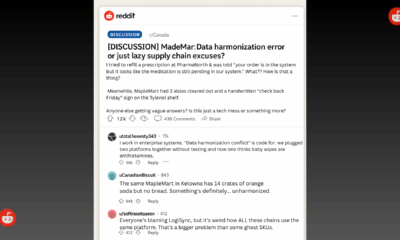Business
Insurance Without a Safety Net? Canadian Firms Face Premium Hikes Amid Cyber Liability Crisis

Toronto, ON —
July 4, 2025 — As ransomware incidents and data breaches continue to spike across Canada, many mid-sized firms are now finding themselves priced out of the very protection they need most: cyber insurance.
According to a new report from the Maple Risk Institute, premiums for cyber liability coverage in Canada have risen by an average of 41% year-over-year, with some sectors — including legal services, logistics, and private healthcare — seeing even steeper increases or flat-out denials.
“Insurers are spooked,” said Arjun Patel, a senior risk analyst at Maple Risk. “Claims are skyrocketing, and the underwriting models weren’t built for this volume or complexity of cyber incidents.”
One major driver, Patel says, is a wave of quiet ransomware settlements, particularly after last year’s high-profile breach at Regal Processing Group, a national payroll processor that reportedly paid a seven-figure ransom to avoid a class-action lawsuit from affected clients.
“The insurers paid out quietly, but now they’re passing those losses straight down the chain,” he added.
A Shrinking Pool
Of the 12 major insurers that offered cyber liability coverage in Canada in 2022, only seven are actively writing new policies today, and many have added stringent preconditions, including mandatory penetration testing and proof of MFA enforcement across all endpoints.
“For a lot of companies, especially outside urban tech hubs, these conditions are unrealistic,” said Tara Muir, COO of logistics firm NorthTrak Freight. “We’re being told to upgrade our security stack or be denied coverage — but we can’t afford the upgrades without the coverage.”
A Risk Spiral in Progress
Experts warn that without accessible insurance, smaller firms may choose to underreport or hide breaches, leading to downstream damage in interconnected supply chains and customer networks.
“The cyber risk spiral is real,” said Patel. “Less coverage means more exposure, which means more cautious insurers, which means even less access.”
Government regulators have yet to propose a cyber insurance backstop or subsidy, though internal Treasury Board memos — leaked earlier this month — reportedly cite it as a “long-term consideration” under national risk modeling.
Following the risk behind the ROI. — Leila Park
Business
Satellite Error Causes Widespread Banking and Transit Disruptions

November 11, 2025 — Monday’s unexpected disruption across Canada’s banking and transit systems has raised new questions about how vulnerable the country’s digital backbone has become to invisible faults, and how easily precision can unravel at scale.
For nearly six hours, payment terminals, trading systems, and commuter networks were thrown into chaos after a timing fault aboard a SkyGrid Communications satellite sent inaccurate synchronization signals to ground-based systems. The result: frozen transactions, halted trades, and locked transit gates across major cities.
From Vancouver’s transit cards to Toronto’s stock exchange, the pattern was clear — infrastructure that once seemed distinct now depends on the same unseen heartbeat pulsing from orbit. When that heartbeat falters, the whole system stumbles.
“It’s astonishing how much of modern life runs on the assumption that time is perfect,” said Dr. Amira Doucette, a cybersecurity researcher at Laurentian University. “When your clocks drift, your trust drifts. Every financial ledger, every secure transaction — it all breaks down.”
The incident began around 9:14 a.m. Monday, when banks, telecom carriers, and public transit systems started reporting timestamp errors. While SkyGrid initially described it as a “configuration anomaly,” federal investigators are not ruling out the possibility of deliberate interference.
“This wasn’t an outage you could see,” said a senior government analyst familiar with the investigation. “It was silence — and in that silence, everything froze.”
By mid-afternoon, synchronization was restored, and queued transactions began replaying. But experts say the episode exposed just how fragile Canada’s digitized economy has become. A single orbital fault managed to slow millions of micro-interactions across sectors, revealing the extent to which precision timekeeping underpins the nation’s trust infrastructure.
Some officials privately compared the event to cyber-operations seen abroad — where technical disruptions are used to mask deeper intrusions or manipulate public confidence. Though SkyGrid maintains there’s no evidence of compromise, the cascading nature of the failure has left analysts uneasy.
“This is the modern equivalent of a power outage,” said Michael Gervais, a former CSE official. “Except now, it’s not the lights that go dark — it’s the systems that decide what’s true, secure, and synchronized.”
A post-incident review is underway involving the Canadian Space Agency, Public Safety Canada, and the CSE, examining why redundant ground links failed to take over and whether the anomaly was purely technical.
For most Canadians, the disruption was temporary — a few failed payments, a stalled subway gate, a flickering stock ticker. But for those watching closely, it marked something bigger: the moment a nation glimpsed how its digital world could falter not from an attack or storm, but from a second of silence above the clouds.
Following the risk behind the ROI. — Leila Park
ODTN News’ Ayaan Chowdhury contributed to this report.
Business
Employee Speaks Out: “We Were Told to Power the Profits, Not the People.”

A siberX Power Co. employee has come forward alleging that internal recovery priorities were deliberately skewed toward restoring AI data centres and corporate clients before power was returned to critical services and residential zones.
In an interview with ODTN News, the employee, who requested anonymity for fear of retaliation described the atmosphere inside the company as “tense, chaotic, and corporate-first.”
“We were watching hospitals run on fumes while being told to focus on data clusters feeding multimillion-dollar contracts,” the source said.
“The CEO’s message was loud and clear — get the AI back online, everything else can wait.”
The leak follows an internal email from SPC’s CEO, Elise Varnholt, reportedly instructing teams to “prioritize compute capacity” and “avoid discussing client names” in public statements. The email, which surfaced on social media late Monday, has drawn heavy criticism from officials and citizens alike.
Regulators at the Alberta Electric System Operator (AESO) have acknowledged awareness of the directive but declined to comment on “ongoing operational decisions” during recovery efforts.
Meanwhile, public frustration continues to mount as large sections of southern Alberta remain without full power four days after the blackout began.
Energy analysts warn that the fallout could extend beyond infrastructure — raising questions about corporate ethics, crisis leadership, and the role of AI-driven industries in critical grid planning.
“When profit dictates the order of recovery, public trust doesn’t just flicker — it burns out,” said Dr. Anika Shah, a crisis management researcher at McGill University.
ODTN.news will keep you updated on this shocking story as we uncover more of the truth behind the crisis.
Following the risk behind the ROI. — Leila Park
ODTN News’ Mira Evans & Ayaan Chowdhury contributed to this report.
Business
siberX Mart Supply Chain Snarled as Digital Transformation Faces Cyber Threats

VANCOUVER, BC —
September 9, 2025 — siberX mart, one of Vancouver’s fastest-growing retail chains, is facing mounting supply chain turmoil after suppliers confirmed they have halted shipments due to breakdowns in the company’s ordering systems.
Distributors tell ODTN News that orders are no longer being confirmed through siberX mart’s digital platform, creating uncertainty about where and when truckloads should be delivered. Several store teams across British Columbia report being told to “hold tight” until directives arrive from the company’s Vancouver head office.
“We can’t send full shipments blind,” said one distributor, speaking on condition of anonymity. “If the system isn’t giving us the green light, we risk losing thousands in misrouted stock.”
A Digital Ambition Stalled by Cyber Risk
The disruption comes at a sensitive time for siberX mart’s leadership. CEO Adrian Blake has been championing a sweeping digital transformation initiative, pitching it as the company’s path toward faster growth and real-time supply chain visibility.
But insiders now suggest the project is faltering under the weight of cybersecurity threats and system vulnerabilities. According to industry analysts, the platform’s instability may have exposed gaps in both resilience and crisis planning.
“When your ordering backbone goes dark, it doesn’t just delay shipments — it undermines trust,” said Dr. Serena Choi, a retail technology expert at the Pacific Cyber Institute. “For siberX mart, the optics are that their big digital bet is going sideways.”
Customer Impact Grows
Meanwhile, shelves at several siberX mart locations are running low on high-demand essentials. Frustrated customers are taking to social media to vent about empty aisles and unanswered questions, with some calling the silence from corporate “unacceptable.”
So far, siberX mart has not issued a public statement addressing the cause of the disruption or providing a timeline for resolution.
For a company that has staked its reputation on technological modernization, the incident is a high-profile reminder that innovation without resilience carries serious risks.
ODTN News will continue monitoring this story as siberX mart works to restore order and confidence in its systems.
Following the risk behind the ROI. — Leila Park
ODTN News’ Mira Evans & Ayaan Chowdhury contributed to this report.
-

 Retail Watch4 months ago
Retail Watch4 months agoCalgary Small Business Hit by Sudden Payment Outage, Sparks Cybersecurity Concerns
-

 Public5 months ago
Public5 months agoReddit Thread Over ‘Inventory Drift’ Surges as Canadians Vent Over Retail Glitches
-

 Cybersecurity5 months ago
Cybersecurity5 months agoCanadian Airline NorthSky Faces Cyberattack, Disrupting Online Services
-

 Business8 months ago
Business8 months agoCanadian Software Vendor Breach Exposes Cloud Environments Across Energy Sector
-

 Retail Watch5 months ago
Retail Watch5 months agoUnderstaffed and overwhelmed, IT teams face rising pressure as retail digitization accelerates
-

 Business4 months ago
Business4 months agoAre Canadian Companies Learning from Global Cyber Attacks? Insider Insights into the Secret Downfall of Canadian Businesses
-

 Politics4 months ago
Politics4 months agoNationwide Government System Outage Paralyzes Public Services
-

 Politics5 months ago
Politics5 months agoCanada, ESB Sign Digital Security Pact to Counter Global Telecom Threats















